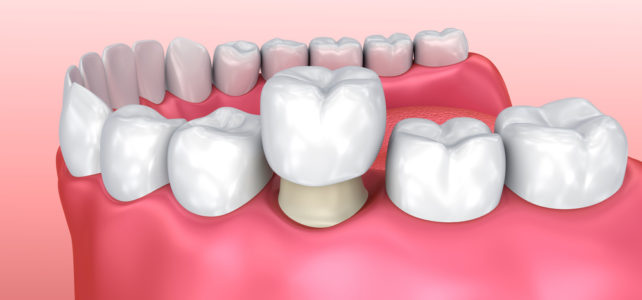
A crown is a dental restoration in the form of a cap which encircles and completely covers a tooth. The cap is bonded to the tooth, and so takes the shape of the tooth, thus protecting the tooth and giving the tooth improved shape, size, colour and strength.
Do I need a crown?
If you have a large cavity which is threatening the strength of your tooth, a filling will not provide adequate strength to the tooth, and so a crown would be advised.
The tooth has fractured due to trauma and there is not much sound tooth structure remaining, a crown would protect the remaining tooth structure.
The tooth has had a root filling, and thus needs to be protected to prevent future fracture and repeat infection.
For cosmetic reasons, a crown can be used to improve the appearance of your teeth.
If you have an implant, the implant is restored with a crown.
The tooth may need to be crowned in order to help with the retention of a denture.
You have experienced tooth surface loos due to erosion (acidic diet) or attrition (grinding or bruxism), the remaining tooth structure would need to be protected with a crown to prevent further erosion or attrition.
What types of crowns are there?
The type of crown is dependant on the material used to make the crown. These days there are so many options to choose from, and most of the time, the choice is case dependant. All of the options below are available to Covent Garden Dental Spa clients looking for dental crowns in central London.
Porcelain fused to metal:
A metal alloy is used on the inner core, and then tooth coloured porcelain is fused to the metal.
Advantage: They are very strong due to having the metallic core
Disadvantage: After a while, the metal may start to show through at the gum margin
Porcelain or ceramic crowns:
There are metal free crowns.
Advantage: They have better cosmetic appearance
Metal:
These crowns can be gold, or non-precious metal crowns.
Advantage: They provide strength in situation of heavy forces, for instance if someone is a heavy grinder.
Disadvantage: They do not have the best aesthetics.
What does the procedure involve?
Two appointments will be needed to make your crown:
Appointment 1
This is the appointment where the dentist makes the necessary reductions to the tooth which will have the crown. The missing tooth structure will be replaced with the restorative crown material. After the reduction is carried out, an impression or mould of the tooth is taken using a putty material. The impression is sent to the laboratory and the technician will make the crown based on the information he sees on the impression. The dentist will cover the tooth undergoing treatment with a temporary crown to protect the tooth while the crown is being made. The dentist will check what colour your teeth are to make sure the new crown matches the rest of your teeth.
Appointment 2
This appointment is normally 2 weeks after the first appointment depending on how long the technician takes to make your crown. At this appointment, the dentist will remove the temporary crown and try in the permanent crown. If the crown has a good fit and you are happy with the look and feel of the crown, it will be cemented with resin cement. The dentist will ensure that you are able to clean the crown well, and that you are able to bite normally as before. Once in a while, repeat appointments are required to ensure a good fit.
What are the advantages of a crown?
They provide the tooth with more strength than any of the other alternatives such as veneers, composite bondings.
What are the disadvantages of a crown?
- Preparation can involve removal of sound tooth structure
- The procedure can be expensive, but worth it in order to restore your tooth
How long does a crown last?
We usually say 10-15 years, but this is dependant on you maintaining good oral hygiene, and visiting the dentist regularly for check-ups and hygiene sessions.
What are the alternatives to a crown?
Depending on the individual situation, one might be able to consider a veneer, composite bonding, inlays or onlays which are less invasive but will not necessarily provide the strength required.
